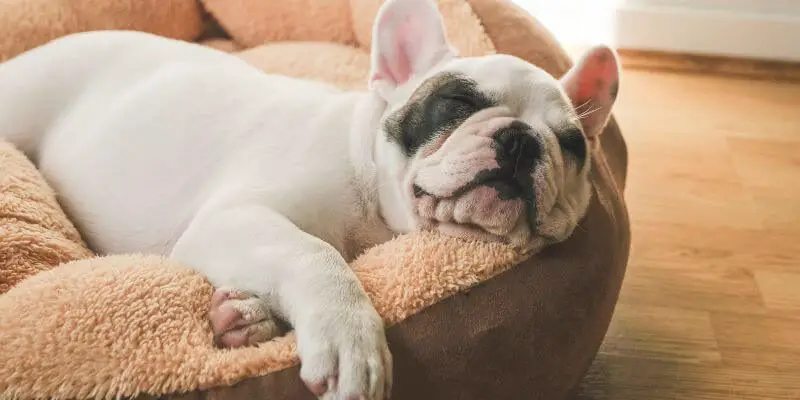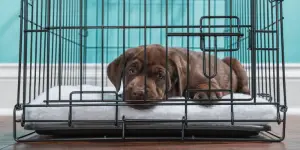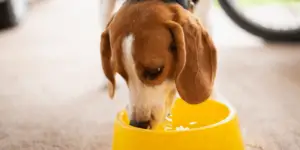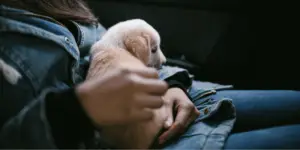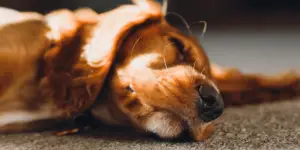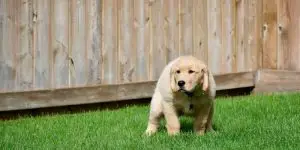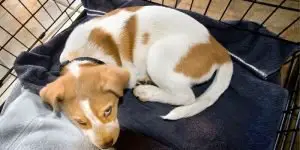
Do puppies dream?
Yes! Puppies do dream – they even dream of normal experiences from day-to-day life, just like humans.
In fact, dogs dream similarly to humans, which means they think of everyday experiences and replay things that have happened to them during the day while they are asleep.
How do we know puppies dream?
We know puppies dream due to a study that was conducted by researchers at MIT in 2001. They measured a group of rats’ brain activity while they ran through a maze, then compared it against their brain activity during REM sleep.
The researchers found that the rats’ brain activity while asleep was identical to when they were running. This showed that the rats were dreaming about the maze they’d gone through earlier, similar to how you might dream about your job after being at work that day.
As rats are less intelligent than both dogs and cats, researchers believe that dogs and cats dream similar to the way rats do.
How often do puppies dream?
Both puppies and small breeds have shorter but more frequent dreams than most dogs. Compared to large breeds that have dreams lasting up to 5 minutes, pups and small pooches dream for around 60 seconds every 10 minutes.
Puppies also tend to stay in REM sleep for longer than adult dogs as they are constantly processing new things and experiences.
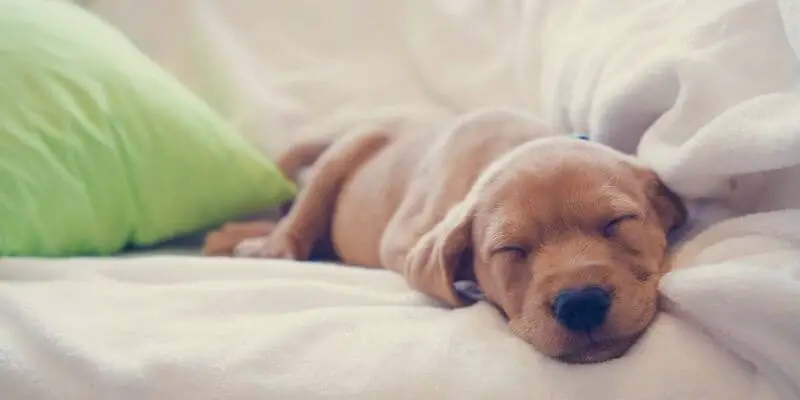
What do puppies dream of?
While there is no real way to know exactly what puppies dream about, scientists believe dogs dream of everyday experiences, as we do. This might be chasing a ball, spending time with their favorite person, or even something negative like having a bath.
You might be able to guess what your puppy is dreaming about by thinking back to what they did earlier in the day. For instance, if your pup went on a walk and met a new doggy friend, they could be replaying that memory and dreaming about their new pal.
Alternatively, they could be dreaming about something bad that happened to them that day. One owner in an interview with a Harvard psychologist revealed that their pooch had experienced a nightmare about a recent bath time. The dog dislikes baths and always hides between its owner’s legs after having one.
It’s important to note that the dog doesn’t repeat this behavior for any other activity. On one occasion, the owner witnessed their dog having a dream. After the dog woke up, they immediately ran over to their owner to hide, leading the owner to believe that their dog was having a nightmare about bath time.
Researchers have also performed tests to deduce what dogs may be dreaming of. In one such test, the pons in a group of dogs was temporarily disabled. If you’re unfamiliar with what the pons is, it’s the part of the brainstem in humans and other bipeds that controls the autonomic nervous system.
These automatic functions include things you and your dog do without thinking, such as digesting and breathing. The pons also plays an important role in REM sleep by sending signals to relax muscles, allowing you to dream without acting them out.
In puppies and senior dogs, the pons is undeveloped and more inefficient, causing them to move and twitch frequently in their sleep.
With the pons disabled, the dogs began to act out their dreams. This allowed researchers to get a good idea of what the dogs were thinking about while asleep, which they concluded were experiences associated with being a dog, like ‘pointing’ at dream birds or chasing something.

Dog sleep patterns and dreams
Dogs are polyphasic sleepers, which means they sleep in small but frequent amounts throughout the day. Humans, on the other hand, are monophasic sleepers as we sleep in one long stretch at night.
While asleep, dog and human brains function almost identically and display different brain wave patterns depending on the stage of sleep. When your pooch first falls asleep, it’s known as slow-wave sleep (SWS).
During this phase, your dog’s heart rate and breathing will slow down, and their blood pressure will drop. However, your pooch will not be fully relaxed and can be easily woken up.
After around 10 to 20 minutes of light sleep, your companion will enter REM (Rapid Eye Movement) sleep. This stage causes your dog’s brain waves to move faster and more irregularly, similar to when they’re awake.
Your pooch’s muscles will relax but their brain will be more active, leading to behaviors like twitching, whimpering, barking, and eyes darting quickly beneath the eyelids.
These signs are all indicative of dreaming, which is most likely to occur during the REM stage. While your puppy is in this phase, they will be difficult to wake, and doing so may result in an aggressive response.
Dogs have much shorter sleep cycles than humans, typically lasting for 45 minutes. During a nap, a dog will enter REM sleep and non-REM sleep twice, spending around 6 minutes during the REM (dream) phase.
Is my puppy dreaming or having a seizure?
A dreaming puppy can look a bit like they’re having a seizure if you’re not sure of the differences between the two. Fortunately, there are a few ways to tell whether your dog is snoozing or suffering from a fit.
Firstly, if your pooch is simply asleep, their limbs should feel flexible and soft. Dogs suffering from a seizure, on the other hand, will have stiff and rigid limbs. Seizures also cause more violent movements that last considerably longer than a dog that is twitching as a result of REM sleep.
During a fit, puppies will be unresponsive and may urinate or defecate. Once the seizure has subsided, it’s not uncommon for dogs to drool, pant, and be visibly disoriented.
If your puppy is mildly twitching, whimpering, breathing fast, or barking in their sleep, it’s likely that they were only dreaming. That being said, if you’re concerned, gently try to wake your pooch up or drop an object on the floor and check their reaction.
If your puppy jolts awake, you’ll know that they were having a dream. However, if you’re unable to wake them and they are displaying the aforementioned signs of a seizure, calmly move them to a safe area where they can’t injure themselves.
Speak to your puppy in a soothing voice and place cold wet towels on their head, neck, and groin as seizures rapidly increase body temperature. Time the length of your puppy’s seizure so you can pass this information on to your vet.
As your puppy comes around, they will be confused and disoriented, so be sure to show them plenty of affection. Make sure they have access to fresh water and some food but don’t force them to eat or drink if they don’t want to.
Leave your puppy to rest – seizures take up a considerable amount of energy, so your pooch is likely to be exhausted. Book an appointment with your vet straight away, especially if they have more than one seizure in a 24-hour period, so they can identify the cause of the seizure.
If your puppy has more than one seizure in a 24-hour period, this is a veterinary emergency, so How do you know if your puppy is having a bad dream?
You can tell whether your puppy is having a bad dream based on their reactions while asleep. For instance, if your pup is wagging their tail, they’re likely dreaming of something positive!
Whimpering or barking, however, could mean that your pooch is having a nightmare.
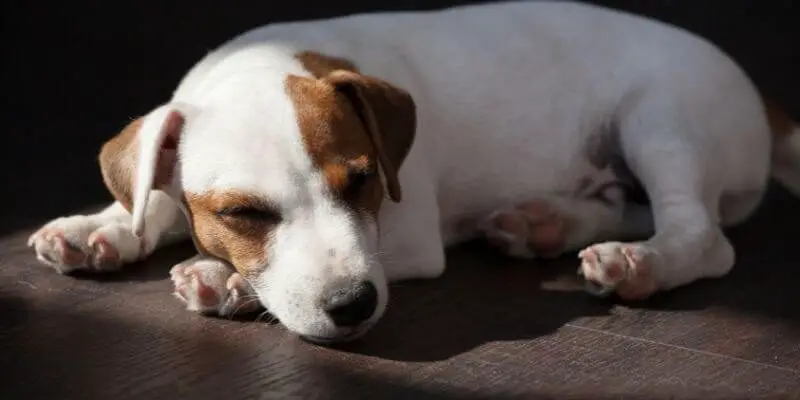
Is it OK to wake a dreaming puppy?
It’s best to leave a puppy well alone while asleep, especially if they are in the REM stage. As mentioned earlier, dogs are difficult to wake up, and doing so suddenly could result in an aggressive reaction.
Imagine someone disturbing you during a deep slumber. You’re likely to be groggy and disoriented – and the same goes for your puppy!
If you need to wake your puppy up for some reason, be gentle and slow. Softly call your dog’s name and lightly tap their rear so you don’t startle them.
How much do puppies sleep?
Puppies sleep a lot more than adult dogs as they need ample rest to grow up to be big and strong. Young pups usually sleep for around 18 to 20 hours a day, but as they get older, this duration will gradually decrease.
Once a dog reaches 6 months old, they will usually snooze for around 16 hours a day. Adult dogs, on the other hand, only sleep for between 8 to 13.5 hours.
Final thoughts
Although there’s no surefire way to figure out what your puppy dreams about, you can get a pretty good idea based on their daily schedule and behavior during a nap. Most dogs dream of normal day-to-day life, such as their favorite owner and what they did earlier that day.
The next time your pup settles down for a nap, recall what happened to them earlier in the day to see if you can guess what they might be dreaming about!
References
- https://www.southernliving.com/culture/pets/do-dogs-dream#:~:text=%22Small%20dogs%20and%20puppies%20dream,dream%20time%20between%20dreaming%20sessions.
- https://www.akc.org/expert-advice/lifestyle/what-do-dogs-dream-about/
- https://www.akc.org/expert-advice/lifestyle/do-dogs-dream/
- https://vcahospitals.com/know-your-pet/do-dogs-dream#:~:text=Unlike%20humans%2C%20dogs%20can%20not,dogs%20do%2C%20indeed%2C%20dream.
- https://www.purina.co.uk/articles/dogs/behaviour/common-questions/do-dogs-dream#:~:text=If%20your%20dog%20is%20simply,they%20feel%20threatened%20or%20anxious.
- https://www.pumpkin.care/blog/why-do-dogs-sleep-so-much/
- https://www.livescience.com/53743-dog-dreams.html

Written by: Joshua Gordon
Head of Research and Editorial, Joshua has over 7 years of experience as a finance and automotive research consultant. He is a childhood pet owner and dog enthusiast.

